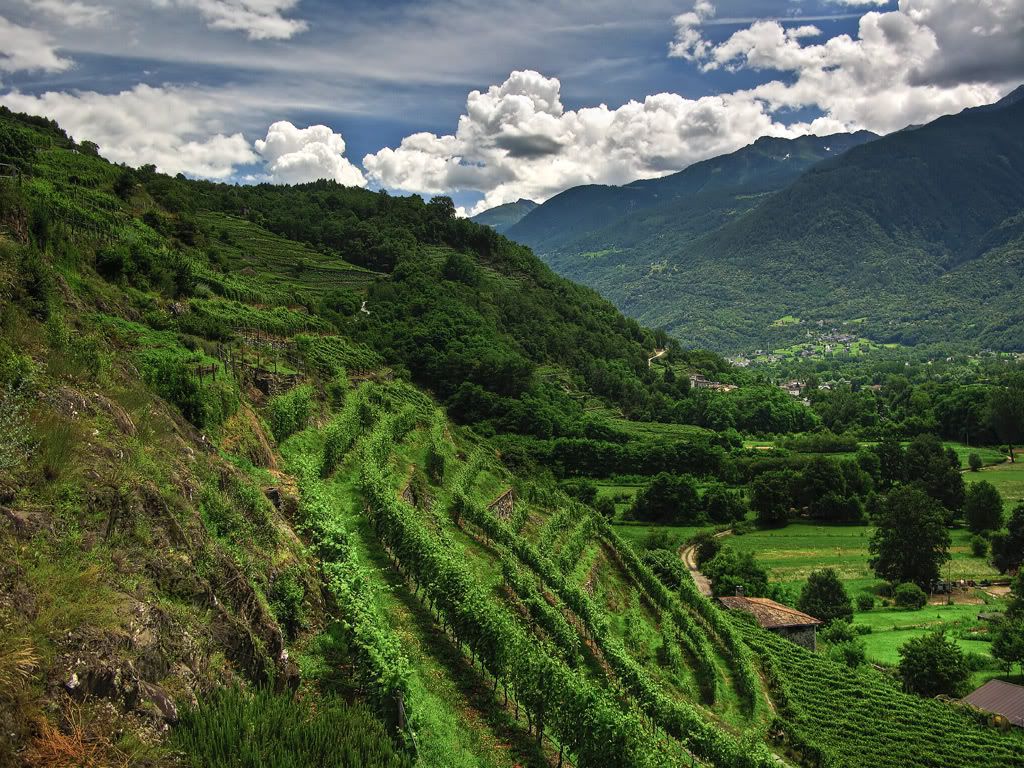 |
| The beautiful Valtellina |
The Valtellina is an Alpine valley which runs about 80 miles east-west, and is about 50 miles from the cities of Brescia and Bergamo, and the flat lands of the Po; so it's rather isolated from a historical point of view. The northernmost village of the Val Camonica, Edolo, is close to the village of Aprica of the Valtellina. The Aprica pass separates the two. The two valleys, their cultures, and their histories are very similar. The following article is from the Lombardi nel Mondo website. I did my best to translate it, often rewriting muddled portions in an attempt to get at what I thought was the true meaning. It at least gives some idea of the old experiences. You almost have to think of... perhaps movies which show very desolate locations, maybe set in the late 1800s. 'Butch Cassidy and the Sundance Kid', in the sequence when they went down to Bolivia, comes to mind. Beyond the east coast cities of Australia, maybe 100 miles inland, are the farmlands; and maybe that's part of where this took place. Of course, in 1860 or 1890, this was a very underdeveloped area. Later in the article, I think they were referring to maybe the 1940s or 50s. I remember of reading some really old accounts of what overseas employers, from the perspective of Europeans, thought of workers from certain regions... and what types of work they're good at. I recall something like.. people from the Italian Alps, Slovaks, Hungarians, etc. are good at heavy work. In other words, in contrast to modern perceptions, they didn't drag people all the way over from the middle of the rural Alps on the other side of the planet just to do very hard work that Aborigines or some little islanders could do.
 'Valtellinese Emigration to Australia (1860-1960)'
'Valtellinese Emigration to Australia (1860-1960)' From letters of migrants and third party migration development
From this we can understood the early migrations from the Valtellina, deepening the meanings and expectations of this history. Perhaps, as they had feared opponents of immigration, some of the early migrants to Australia were attracted by widespread tales of gold or of a country of plenty from emigration agents, but any such illusion was short-lived. The temporary emigrants were not on their way to a generic "Australia," but headed for specific locations, looking for a specific job. In Australia you could make some good gains, but at the price of a very hard effort and lack of any attractiveness and with great personal sacrifice. More often than not they found themselves engaging in grueling logging work in remote areas, cutting sugar cane in tropical heat, or risking their lives in underground mines. The rhetoric used by emigrants in the description of their travels is revealing: "making sacrifices" was the term used to talk about these migrations. Australia had become famous not as a country of plenty, but as a place of hard work. Since they were temporary migrants, they departed without knowing the language; and they did not come with women or families, and they did not sell their lands before leaving. Their goal was to make the highest profit in the shortest possible time, in the hope of a quick return home. They probably started with few illusions. The idea was to get through the burden of the work load stoically, sit tight and hope that they can maintain their health and safety. Normally there was no intention to settle permanently.
The presence of Lombards in Australia, and more generally of people originating from Italy, was noted by the consuls and consular agents of Italians after the discovery of gold in the State of Victoria in 1851. The Valtellinese presence was known in those areas and to the agents of the shipping companies which operated in moving Swiss citizens not far from the border from Valtellina, in the Valley of Poschiavo in the Canton of
 |
| Rural Australia |
Returnees had described the unfavorable treatment accorded to them by the authorities and employers in America, while Australia had proved very hospitable. In the Valtellina, a culture of migration had developed, especially to Australia; thereby ensuring that in years to come, the majority of emigrants would follow already beaten paths. Several routes were opened in Australia since 1890. The most important would lead migrants to Western Australia, to regions where there was a focus on extractive activities and of the harvesting of timber. Especially after World War II, the northern regions of Queensland opened up in the sugar cane plantations. For many years the migrants made significant progress from the fruit of their labor, to the point that they began to consider settling permanently in the country. It was starting to become apparent that with these changes, people were deciding to make Australia their home. Their lives were simple but decent, and of which their old traditions and habits continued on. It was similar to their old village life, and less like Anglo-Saxon proletarian life. They toiled all day in the fields, pulling plows, but when they returned home in the evening to a nice home, bath, dinner, and a car to drive to town to the cinema. At the tables were always their native cuisine; lots of macaroni, salads, and buttered bread, along with cups of tea.
Source: Jacqueline Templeton, 'From the Mountains to the Bush: Emigration of Valtellinese in Australia (1860-1960) from the Letters of Migrants'; Tirano Museum, 2001
.

No comments:
Post a Comment